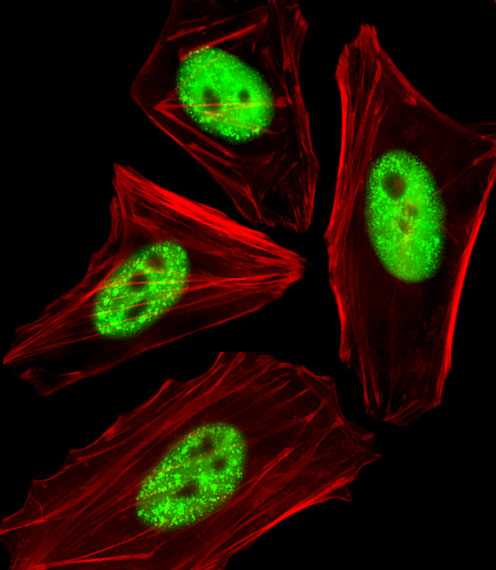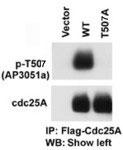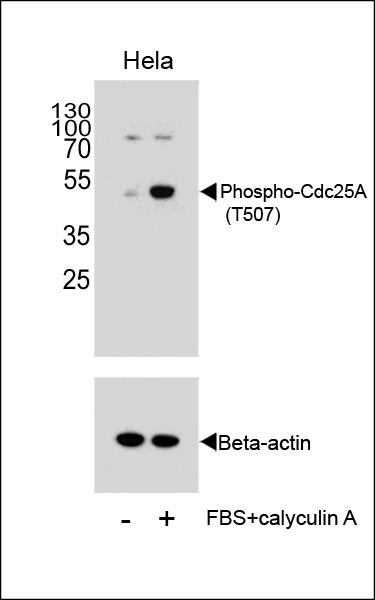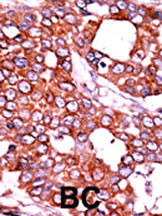Phospho-CDC25A(T507) Antibody
Affinity Purified Rabbit Polyclonal Antibody (Pab)
- SPECIFICATION
- CITATIONS: 2
- PROTOCOLS
- BACKGROUND

Application
| IF, WB, IHC-P, E |
|---|---|
| Primary Accession | P30304 |
| Other Accession | P48965, P48964, A7MBD1 |
| Reactivity | Human |
| Predicted | Bovine, Mouse, Rat |
| Host | Rabbit |
| Clonality | Polyclonal |
| Isotype | Rabbit IgG |
| Calculated MW | 59087 Da |
| Antigen Region | 480-514 aa |
| Gene ID | 993 |
|---|---|
| Other Names | M-phase inducer phosphatase 1, Dual specificity phosphatase Cdc25A, CDC25A |
| Target/Specificity | This CDC25A Antibody is generated from rabbits immunized with a KLH conjugated synthetic phosphopeptide corresponding to amino acid residues surrounding T507 of human CDC25A. |
| Dilution | IF~~1:25 WB~~1:250 IHC-P~~1:50~100 E~~Use at an assay dependent concentration. |
| Format | Purified polyclonal antibody supplied in PBS with 0.09% (W/V) sodium azide. This antibody is purified through a protein A column, followed by peptide affinity purification. |
| Storage | Maintain refrigerated at 2-8°C for up to 2 weeks. For long term storage store at -20°C in small aliquots to prevent freeze-thaw cycles. |
| Precautions | Phospho-CDC25A(T507) Antibody is for research use only and not for use in diagnostic or therapeutic procedures. |
| Name | CDC25A |
|---|---|
| Function | Tyrosine protein phosphatase which functions as a dosage- dependent inducer of mitotic progression (PubMed:12676925, PubMed:14559997, PubMed:1836978, PubMed:20360007). Directly dephosphorylates CDK1 and stimulates its kinase activity (PubMed:20360007). Also dephosphorylates CDK2 in complex with cyclin-E, in vitro (PubMed:20360007). |

Provided below are standard protocols that you may find useful for product applications.
Background
CDC25A is a member of the CDC25 family of phosphatases. CDC25A is required for progression from G1 to the S phase of the cell cycle. It activates the cyclin-dependent kinase CDC2 by removing two phosphate groups. CDC25A is specifically degraded in response to DNA damage, which prevents cells with chromosomal abnormalities from progressing through cell division. CDC25A is an oncogene, although its exact role in oncogenesis has not been demonstrated. Two transcript variants encoding different isoforms have been found for this gene.
References
Ito, Y., et al., Int. J. Mol. Med. 13(3):431-435 (2004). Nemoto, K., et al., Prostate 58(1):95-102 (2004). Goloudina, A., et al., Cell Cycle 2(5):473-478 (2003). Chen, M.S., et al., Mol. Cell. Biol. 23(21):7488-7497 (2003). Chow, J.P., et al., Mol. Biol. Cell 14(10):3989-4002 (2003).
If you have used an Abcepta product and would like to share how it has performed, please click on the "Submit Review" button and provide the requested information. Our staff will examine and post your review and contact you if needed.
If you have any additional inquiries please email technical services at tech@abcepta.com.














 Foundational characteristics of cancer include proliferation, angiogenesis, migration, evasion of apoptosis, and cellular immortality. Find key markers for these cellular processes and antibodies to detect them.
Foundational characteristics of cancer include proliferation, angiogenesis, migration, evasion of apoptosis, and cellular immortality. Find key markers for these cellular processes and antibodies to detect them. The SUMOplot™ Analysis Program predicts and scores sumoylation sites in your protein. SUMOylation is a post-translational modification involved in various cellular processes, such as nuclear-cytosolic transport, transcriptional regulation, apoptosis, protein stability, response to stress, and progression through the cell cycle.
The SUMOplot™ Analysis Program predicts and scores sumoylation sites in your protein. SUMOylation is a post-translational modification involved in various cellular processes, such as nuclear-cytosolic transport, transcriptional regulation, apoptosis, protein stability, response to stress, and progression through the cell cycle. The Autophagy Receptor Motif Plotter predicts and scores autophagy receptor binding sites in your protein. Identifying proteins connected to this pathway is critical to understanding the role of autophagy in physiological as well as pathological processes such as development, differentiation, neurodegenerative diseases, stress, infection, and cancer.
The Autophagy Receptor Motif Plotter predicts and scores autophagy receptor binding sites in your protein. Identifying proteins connected to this pathway is critical to understanding the role of autophagy in physiological as well as pathological processes such as development, differentiation, neurodegenerative diseases, stress, infection, and cancer.




